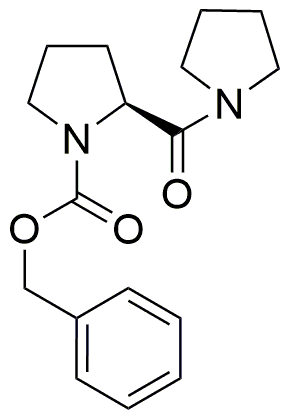Benzyl (S)-(-)-2-(1-pyrrolidinylcarbonyl)-1-pyrrolidinecarboxylate is widely utilized in research focused on:
- Pharmaceutical Development: This compound serves as a key intermediate in the synthesis of various pharmaceuticals, particularly in the development of analgesics and anti-inflammatory drugs, enhancing pain management options.
- Neuroscience Research: Its unique structure makes it valuable in studies related to neuropharmacology, helping researchers explore potential treatments for neurological disorders.
- Organic Synthesis: The compound is used in organic chemistry as a building block for creating more complex molecules, streamlining the synthesis process in laboratories.
- Drug Formulation: It can be incorporated into drug formulations to improve bioavailability and stability, which is crucial for effective medication delivery.
- Biochemical Studies: This chemical is employed in various biochemical assays, aiding in the understanding of enzyme interactions and metabolic pathways.
General Information
Properties
Safety and Regulations
Applications
Benzyl (S)-(-)-2-(1-pyrrolidinylcarbonyl)-1-pyrrolidinecarboxylate is widely utilized in research focused on:
- Pharmaceutical Development: This compound serves as a key intermediate in the synthesis of various pharmaceuticals, particularly in the development of analgesics and anti-inflammatory drugs, enhancing pain management options.
- Neuroscience Research: Its unique structure makes it valuable in studies related to neuropharmacology, helping researchers explore potential treatments for neurological disorders.
- Organic Synthesis: The compound is used in organic chemistry as a building block for creating more complex molecules, streamlining the synthesis process in laboratories.
- Drug Formulation: It can be incorporated into drug formulations to improve bioavailability and stability, which is crucial for effective medication delivery.
- Biochemical Studies: This chemical is employed in various biochemical assays, aiding in the understanding of enzyme interactions and metabolic pathways.
Documents
Safety Data Sheets (SDS)
The SDS provides comprehensive safety information on handling, storage, and disposal of the product.
Product Specification (PS)
The PS provides a comprehensive breakdown of the product’s properties, including chemical composition, physical state, purity, and storage requirements. It also details acceptable quality ranges and the product's intended applications.
Certificates of Analysis (COA)
Search for Certificates of Analysis (COA) by entering the products Lot Number. Lot and Batch Numbers can be found on a product’s label following the words ‘Lot’ or ‘Batch’.
*Catalog Number
*Lot Number
Certificates Of Origin (COO)
This COO confirms the country where the product was manufactured, and also details the materials and components used in it and whether it is derived from natural, synthetic, or other specific sources. This certificate may be required for customs, trade, and regulatory compliance.
*Catalog Number
*Lot Number
Safety Data Sheets (SDS)
The SDS provides comprehensive safety information on handling, storage, and disposal of the product.
DownloadProduct Specification (PS)
The PS provides a comprehensive breakdown of the product’s properties, including chemical composition, physical state, purity, and storage requirements. It also details acceptable quality ranges and the product's intended applications.
DownloadCertificates of Analysis (COA)
Search for Certificates of Analysis (COA) by entering the products Lot Number. Lot and Batch Numbers can be found on a product’s label following the words ‘Lot’ or ‘Batch’.
*Catalog Number
*Lot Number
Certificates Of Origin (COO)
This COO confirms the country where the product was manufactured, and also details the materials and components used in it and whether it is derived from natural, synthetic, or other specific sources. This certificate may be required for customs, trade, and regulatory compliance.


